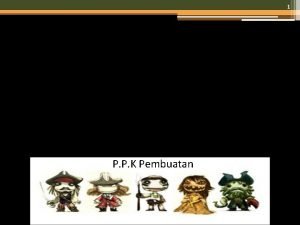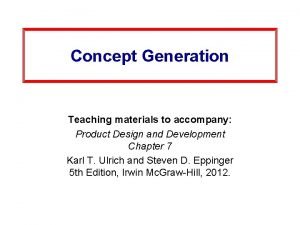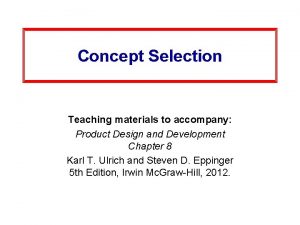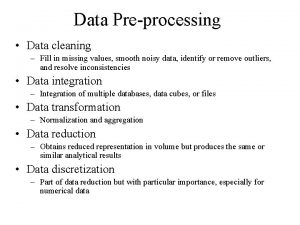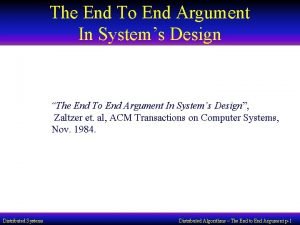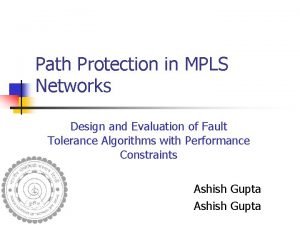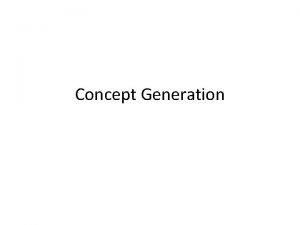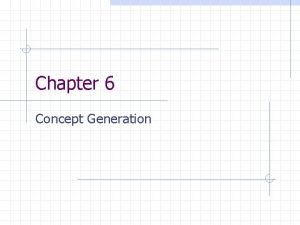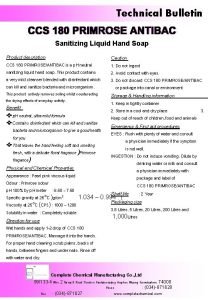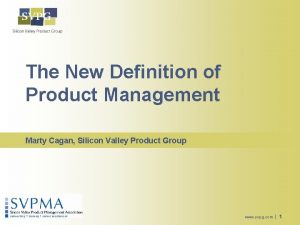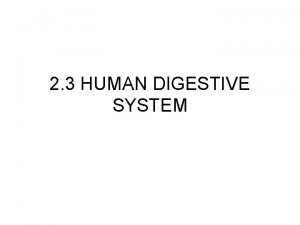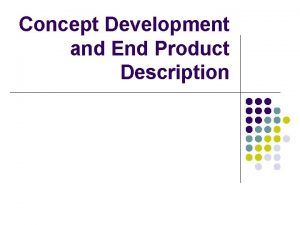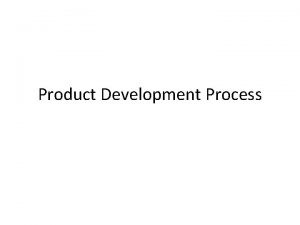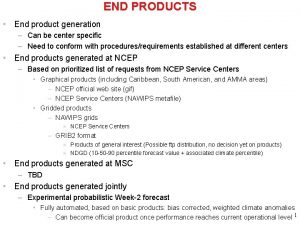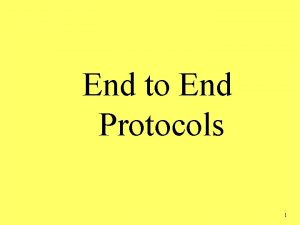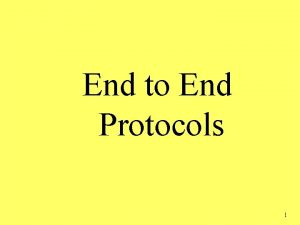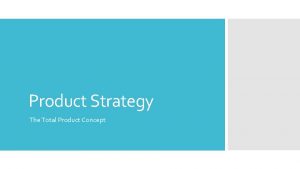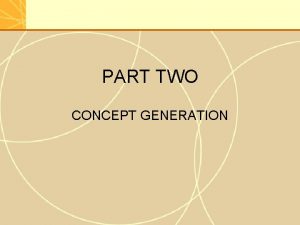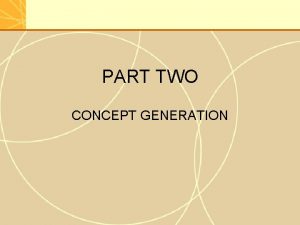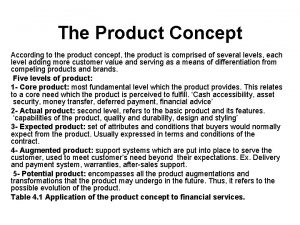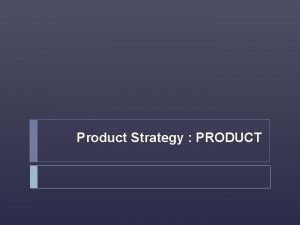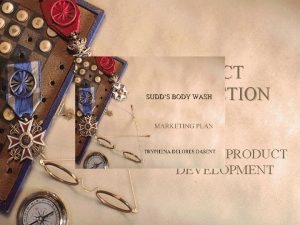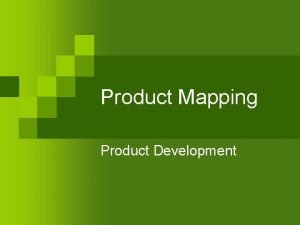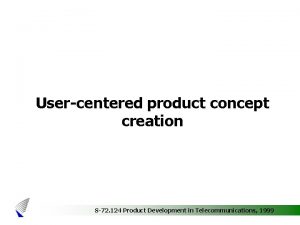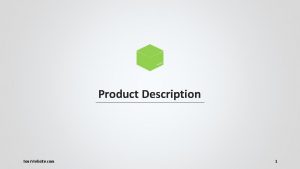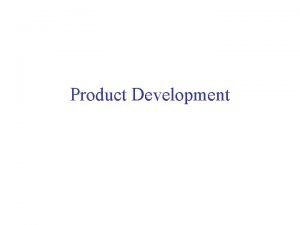Concept Development and End Product Description Concept Generation



































- Slides: 35

Concept Development and End Product Description

Concept Generation

Portable Audio Equalizer Objectives 1. The system should have excellent sound quality. 2. The system should have easy equalization 3. The system should be lightweight 4. The system should be low cost Constraints 1. The system must be portable 2. The system will be an add-on to an existing MP 3 player

Concept Fan l The Concept Fan is a way of discovering alternative approaches to a problem when you have discarded all obvious solutions. It develops the principle of 'taking a step back' to get a broader viewpoint. Initially, the Concept Fan requires you to draw a circle in the middle of a large piece of paper. Write the problem you are trying to solve in the circle. To the right of it radiate lines representing possible solutions to the problem (concepts), see the diagram below: https: //www. mycoted. com/Concept_Fan

Concept Fan l It is possible that the ideas you have come up with are impractical or do not solve the problem. If this is the case, take a 'step back' for a broader analysis of the problem. Drawing a circle to the left of the first circle does this, writing the broader definition into this new circle and linking it with an arrow to show that it comes from the first circle, see diagram below: l Use this as a starting point to radiate out other ideas; if this does not give you an adequate amount of new concepts, you can take yet another step back (and another, and another…) https: //www. mycoted. com/Concept_Fan

Concept Fan

Concept Combination Table l A Concept Combination Table (also called morphology box) is a matrix of concept fragments organized by functions (each function forms a separate column) so that an integrated concept can be created by choosing any concept fragment for each function and combining them to complete the required functionality. https: //books. google. com/books? id=9 Zj. LBQAAQBAJ&pg=PA 114&lpg=PA 114&dq=concept+combination+table&source=bl&ots=ce. Bcn. U Ui 7 f&sig=Pi. CBZe. HApg. ZDjg. YV 2 Etc. YDbu. We. A&hl=en&sa=X&sqi=2&ved=0 ah. UKEwins. Oeq 4 b. TPAh. VJm. R 4 KHe. O 0 D 9 k. Q 6 AEIXDAM#v=o nepage&q=concept%20 combination%20 table&f=false

Concept Combination Table

Concept Combination Table

Concept Combination Table

Concept Selection

Concept Selection

End Product Description In this section you will describe: l. The constituent modules and their interrelationships l. The functionality of the product l. The functionality of the different modules l. Present the product specs

Black Box l In science, computing, and engineering, a black box is a device, system or object which can be viewed in terms of its inputs and outputs (or transfer characteristics), without any knowledge of its internal workings. Its implementation is "opaque" (black). Almost anything might be referred to as a black box: a transistor, an algorithm, or the human brain. https: //en. wikipedia. org/wiki/Black_box

Block Diagram l A block diagram is a diagram of a system in which the principal parts or functions are represented by blocks connected by lines that show the relationships of the blocks. They are heavily used in engineering in hardware design, electronic design, software design, and process flow diagrams. https: //en. wikipedia. org/wiki/Block_diagram http: //www. hobbyprojects. com/block_diagrams. html

End Product Description l l l To obtain the block diagram of a design we use a method based on levels We start with Level 0, which is the black box description of the project. We uncover Level 0 and see the Level 1 modules We continue this process until the step before placing components At each step we provide the modules' functions and interconnection specifications

Level 0 Equalizer Functionality This is the product description without knowledge of the internal blocks (black box)

Level 1 Equalizer Functionality This a general Description of the internal blocks Only Pre-AMP table shown. Show a table for each block

Level 2 Automatic Level control (ALC)

Embedded Systems Require additional Information Pseudo Code or Flow Charts are required

Continue until the next step is to place components

Conventions l l Use buses (Thick lines) to represent several connecting lines that have common origin and destination Terminate the bus with an arrow head at the destination When information flow is bidirectional, place arrows at both ends of the bus When possible indicate the number of lines

Conventions l l At some level of detail all individual lines must show Images from: l l http: //file. scirp. org/Html/16401302_42760. htm and https: //en. wikipedia. org/wiki/ Control_system Remember, stop when the next step is placing components

In Summary l l Describe diagrams in paragraphs with local functionality tables slides (11 to 14) Repeat Functionality Tables l l Put level 0 functionality in one table Group all level 1 functionality tables in one table Repeat for all levels At the end of de section include the Technical Specs that you obtained before

Example




Diagrams and tables must be explained

Diagrams and tables must be explained

Diagrams and tables must be explained

Diagrams and tables must be explained, as in this case.


Diagrams and tables must be explained

Other Deliverables l l Power Point Presentation Final Report User Manual etc
 Product idea development
Product idea development Concept generation in product design
Concept generation in product design Generate product concept example
Generate product concept example Product life cycle kotler
Product life cycle kotler Second generation vs first generation antipsychotics
Second generation vs first generation antipsychotics You are good and your mercy endureth forever
You are good and your mercy endureth forever Concept selection example
Concept selection example Front end and back end in compiler design
Front end and back end in compiler design Backend phases of compiler
Backend phases of compiler Discretization and concept hierarchy generation
Discretization and concept hierarchy generation Stroke volume definition
Stroke volume definition End diastolic volume meaning
End diastolic volume meaning Linksappendizitis
Linksappendizitis Yichao zhou
Yichao zhou End to end argument
End to end argument End to end accounting life cycle tasks
End to end accounting life cycle tasks End to end delay
End to end delay End to end delay
End to end delay End to end
End to end Comet transformer
Comet transformer Multiple procurement cycles
Multiple procurement cycles What is concept generation
What is concept generation Contoh product concept
Contoh product concept Concept generation table
Concept generation table First generation right
First generation right Data reduction in data mining
Data reduction in data mining Central idea of the production
Central idea of the production Product line vs product mix
Product line vs product mix Industry target market feasibility analysis example
Industry target market feasibility analysis example Gnp gdp meaning
Gnp gdp meaning Technical description of a product
Technical description of a product Liquid hand soap product description
Liquid hand soap product description Product management silicon valley
Product management silicon valley End product of aerobic respiration
End product of aerobic respiration The final product of glycolysis is
The final product of glycolysis is End product of fat
End product of fat

